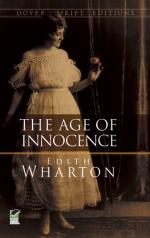Newland Archer had been aware of these things ever since he could remember, and had accepted them as part of the structure of his universe. He knew that there were societies where painters and poets and novelists and men of science, and even great actors, were as sought after as Dukes; he had often pictured to himself what it would have been to live in the intimacy of drawing-rooms dominated by the talk of Merimee (whose “Lettres a une Inconnue” was one of his inseparables), of Thackeray, Browning or William Morris. But such things were inconceivable in New York, and unsettling to think of. Archer knew most of the “fellows who wrote,” the musicians and the painters: he met them at the Century, or at the little musical and theatrical clubs that were beginning to come into existence. He enjoyed them there, and was bored with them at the Blenkers’, where they were mingled with fervid and dowdy women who passed them about like captured curiosities; and even after his most exciting talks with Ned Winsett he always came away with the feeling that if his world was small, so was theirs, and that the only way to enlarge either was to reach a stage of manners where they would naturally merge.
He was reminded of this by trying to picture the society in which the Countess Olenska had lived and suffered, and also—perhaps—tasted mysterious joys. He remembered with what amusement she had told him that her grandmother Mingott and the Wellands objected to her living in a “Bohemian” quarter given over to “people who wrote.” It was not the peril but the poverty that her family disliked; but that shade escaped her, and she supposed they considered literature compromising.
She herself had no fears of it, and the books scattered about her drawing-room (a part of the house in which books were usually supposed to be “out of place"), though chiefly works of fiction, had whetted Archer’s interest with such new names as those of Paul Bourget, Huysmans, and the Goncourt brothers. Ruminating on these things as he approached her door, he was once more conscious of the curious way in which she reversed his values, and of the need of thinking himself into conditions incredibly different from any that he knew if he were to be of use in her present difficulty.
Nastasia opened the door, smiling mysteriously. On the bench in the hall lay a sable-lined overcoat, a folded opera hat of dull silk with a gold J. B. on the lining, and a white silk muffler: there was no mistaking the fact that these costly articles were the property of Julius Beaufort.
Archer was angry: so angry that he came near scribbling a word on his card and going away; then he remembered that in writing to Madame Olenska he had been kept by excess of discretion from saying that he wished to see her privately. He had therefore no one but himself to blame if she had opened her doors to other visitors; and he entered the drawing-room with the dogged determination to make Beaufort feel himself in the way, and to outstay him.




